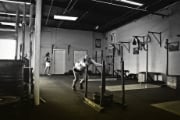Jump Start Your Workout with the Dynamic Warm-Up | BridgeAthletic

What is your typical warm-up routine? Or, perhaps a better question is, do you have a warm-up? So many of us are guilty of squeezing in a quick gym session and cutting the warm-up short or eliminating it altogether. Unfortunately, in training and competition, tightness and soreness is a hindrance and without a proper warm-up you could be wasting precious practice time.
- Increase in performance measures after a dynamic warm-up compared to other warm-ups.1 Performance measures included vertical jump, long jump, 300-yd shuttle run and medicine-ball underhand throw for distance.
- Improvement in balance, agility and movement time in dynamic stretching compared to static stretching.2
- No reduction in overall injury with static stretching.3,4
- Improvement in eccentric quadriceps strength and hamstring flexibility with dynamic warm-up, which may lead to reduced injury risk and improved performance immediately after the warm-up activities, whereas the static stretching did not have this effect.5
Additional Benefits of the Dynamic Warm-Up:6
- Enhanced nerve conductivity (think faster reaction time)
- Faster metabolism
- Decreased resistance of muscles and joints (i.e., more mobility)
- Increased blood flow to muscles
- Elevation of baseline oxygen consumption
- Increased preparedness to train or compete
With so many physiologic and performance benefits, why not incorporate the dynamic warm-up into your own workout? Check out the examples below!
A Dynamic Stretching Warm-Up Routine
The dynamic warm-up typically consists of dynamic stretching with controlled movement through the active range of motion, agility and plyometric activities plus specific motor pattern movements.5 Aim to warm up for 10-20 minutes with a 10-20 second break between segments. There is a considerable amount of variability depending on the sport and level of intensity. Check out this warm-up to try before your next workout.7
Additional Dynamic Movements:
- Side/Front Crossover: Athletes swing both arms out to their sides and then cross them in front of their chest, while moving forward.
- Walking Lunge with Rotation: Athletes take a big step forward and at the same time rotate their arms horizontally.
- Lateral Shuffle: Athletes move laterally without crossing feet
- Frankenstein Walks: Athletes walk with both hands extended in front of the body, palms down, then they kick with the extended leg towards hands.
- Heel-Ups: Athletes kick heels towards buttocks while moving forward.
- Inch Worms: Start in push-up position. Keeping legs extended athletes walk towards hands, and then they walk hands forward while keeping limbs extended (6 repetitions).
- Modified Shuttle Run: Athletes run to the opposite line at a moderate pace (50% maximum speed), bend to touch the line, and return back gradually accelerating (75%) and touch the starting line. After touching the starting line, they run to the opposite line accelerating to near maximum speed (90%), touch the line and return back to the starting line walking.
References:
- Cervantes SJ, Snyder AR. The effectiveness of a dynamic warm-up in improving performance in college athletes. J Sport Rehabil. 2011 Nov;20(4):487-93
- Chatzopoulos D, Galazoulas C, Patikas D, Kotzamanidis C. Acute effects of static and dynamic stretching on balance, agility, reaction time and movement time. J Sports Sci Med. 2014 May;13(2):403-9
- Hart LE, Tarnopolsky M, Lotter A, Canham-Chervack M, Jones BH, Knapick JJ. Does Stretching Before Exercise Prevent Lower Limb Injury. Medical Science Sports Exerc 2000; 32: 271-277.
- Yeung SS, Yeung EW, Gillespie LD. Interventions for preventing lower limb soft-tissue running injuries. Cochrane Database Syst Rev. 2011(7):CD001256.
- Aguilar AJ, DiStefano LJ, Brown CN, Herman DC, Guskiewicz KM, Padua DA. A dynamic warm-up model increases quadriceps strength and hamstring flexibility. J Strength Cond Res. 2012 Apr;26(4):1130-41.
- Bishop D. Warm up I: potential mechanisms and the effects of passive warm up onexercise performance. Sports Med. 2003;33(6):439-5.
- Faigenbaum AD, McFarland JE, Schwerdtman JA, Ratamess NA, Kang J, and Hoffman JR. Dynamic warm-up protocols, with and without a weighted vest, and fitness performance in high school female athletes. J Athl Train. Oct-Dec 2006;41(4):357-363.
Disclaimer: This blog is for informational purposes only. Doctors cannot provide a diagnosis or individual treatment advice via e-mail or online. Please consult your physician about your specific health care concerns.
For additional content on the benefits of warming up, be sure to check out Nick Folker's Pre-Competition Warm-Up.
About the Author

Dr. Emily Kraus is a BridgeAthletic performance team contributor where she focuses on topics that are at the forefront of athletics and medicine. She is the incoming Stanford non-operative sports medicine fellow in Physical Medicine and Rehabilitation. Emily has provided medical coverage for events such as the USATF National Track and Field Championships and is the research coordinator for a multi-center study focused on prevention of stress fractures in division I collegiate runners. Emily has finished six marathons, recently ran (and won) her first 50km trail ultramarathon, and placed 56th female in the 2016 Boston Marathon. Emily is passionate about injury prevention, running biomechanics, and the promotion of health and wellness.
Related Posts

The Best Bench Press Variation You’re...
This post is part of our Coaches Corner series with Taylor Rimmer. Taylor is NSCA-CPT, StrongFirst...

Does Powerlifting Harm Heart Health?
A recent study has discovered that a 12-week supervised strength training program (SSTP) may result...
-1.png)
Barefoot Running: Is It For You? |...
Run Free: Consider Less Cushion
Updated October 2020:
With more athletes looking for ways to...

